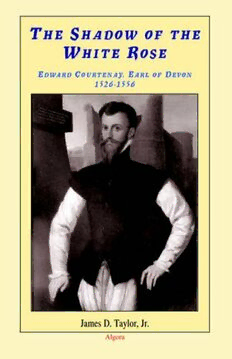
The Shadow of the White Rose: Edward Courtenay, Earl of Devon 1526-1556 PDF
244 Pages·2006·1.578 MB·English
Most books are stored in the elastic cloud where traffic is expensive. For this reason, we have a limit on daily download.
Preview The Shadow of the White Rose: Edward Courtenay, Earl of Devon 1526-1556
Description:
One life may reflect all the tempestuous turbulence of an era. Edward Courtenay spent his life in the best prisons and palaces. Mary Tudor finally released him from the Tower when she seized the throne from Jane Grey after only a nine-day reign. Sometimes referred to as the White Rose because he was the last descendant of the Plantagenets (through his grandmother Catherine, daughter of King Edward IV), Courtenay was soon regarded as a worthy husband for Mary. After he repeatedly rejecting all advances of marriage to Mary and showed no interest in the prospect of being king, it was decided that he should marry Elizabeth, who was next in the order of succession to the crown; but Courtenay showed no interest in that prospect either.Mary then announced her choice for a husband was Prince Philip of Spain. This was not a popular choice with many in the realm and led to the Wyatt rebellion, in which Mary was almost removed from the throne by force (Courtenay and Elizabeth were to reign in her place).Courtenay was again imprisoned but based only on suspicion, as any evidence that could be used against him was altered or destroyed. Released about a year later, he was sent out of England where he traveled through France, Belgium, and Germany and finally arrived in Italy where his activities will most likely remain enshrouded in the shadow of the White Rose.What documentary evidence of his life survive were, for the most part, allowed to survive that became fairly clear during this five-year research project. While reviewing the surviving correspondence to and from Courtenay and other documentation from the period, I learned that, after Courtenay s death, a large cache of his writings was discovered. The Council of Ten in Venice hired a carpenter to open the sealed box containing Courtenay s literary remains and swore him to secrecy. After they reviewed the contents, they removed a certain quantity, replaced the remainder the way they were first discovered, and resealed the box. Many letters were never seen again.It is safe to speculate that the letters the Council removed contained such important political or personal information that someone was willing to commit crimes to prevent their contents from ever being read. Certainly the French would have had the greatest interest in those letters.Perhaps the most frustrating to me was the constant supply of gaps in correspondence in the last three months of his life where a letter should exist but does not. Intriguing are several instances when Courtenay s name was purposely omitted from the translation or decipherment of correspondence that was most likely related to the affairs of King Henry II of France and his ambassadors in England.Courtenay is often absent from biographies on subjects from the period. When he is mentioned, he is described as a bumbling buffoon, ignorant, dull witted, or rash. He was actually quite the contrary, or he surely could not have survived the conspiracies of his time, as I hope the tantalizing material in this book will demonstrate.Table 1. Edward s Family Ancestral Tree Table 2. Edward s Royal Ancestral Tree Chapter One: Edward Courtenay s Ancestry Chapter Two: 1526-July 1553, King Henry VIII and Edward VI Chapter Three: July 1553-February 1554, Queen Jane, Mary and Wyatt s rebellion Chapter Four: February 1554-April 1555, Bloody Mary Chapter Five: April 1555-September 1556, Freedom and Suspicion Chapter Six: Epilogue for Edward Courtenay Chapter Seven: The Lane Letters Chapter Eight: Furthermore Map 1. Areas of Wyatt s proclamations Map 2. Wyatt s attack on London
See more
The list of books you might like
Most books are stored in the elastic cloud where traffic is expensive. For this reason, we have a limit on daily download.
